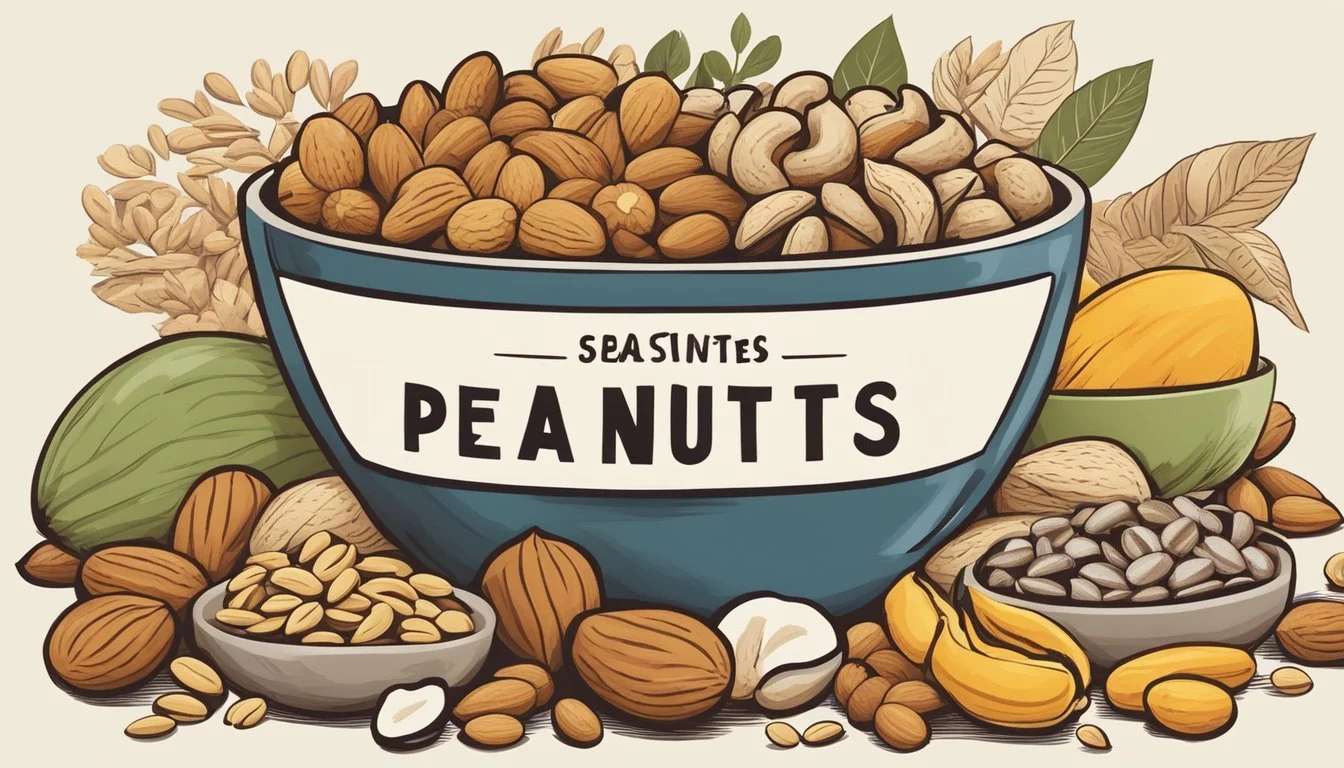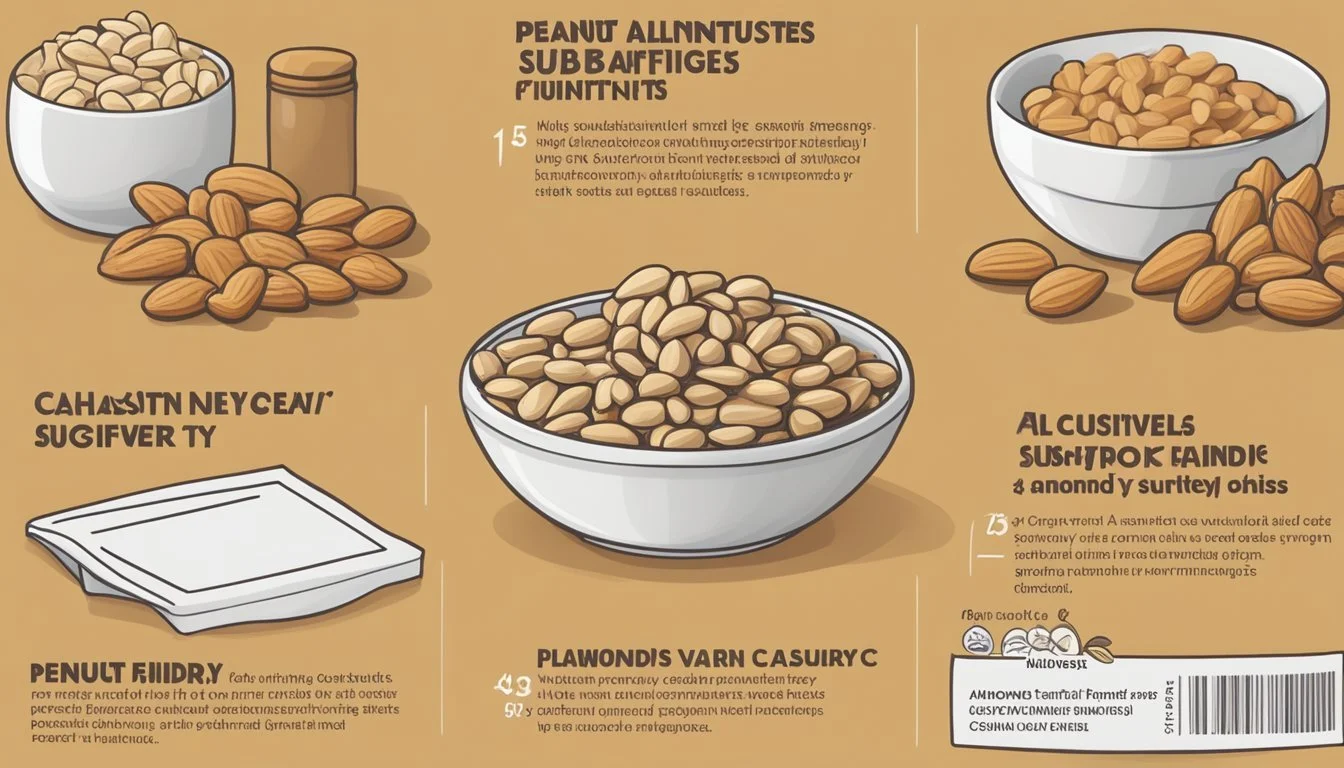Peanuts Substitutes
Top Nut-Free Alternatives for Cooking and Snacking
When dietary restrictions or allergies come into play, finding peanut substitutes can become essential. Roasted chickpeas or beans offer a satisfying crunch and protein content that can easily replace peanuts in savory dishes and salads. Just roast them at 400°F (205°C) for 30-35 minutes after spraying with cooking spray and use on a 1:1 ratio.
Pili nuts and Brazil nuts are excellent alternatives for those who miss the flavor and texture of peanuts in their recipes. Pili nuts, when shelled, offer a close peanut-like flavor, making them perfect for various dishes. Similarly, chopped and roasted Brazil nuts deliver a peanut-type texture that fits well in many recipes.
Other versatile substitutes include hummus, which provides a creamy texture, and sunflower seeds, which are great for snacking and baking. These alternatives ensure that you don't miss out on the essential taste and texture in your favorite recipes, while keeping your meals safe and delicious.
Understanding Peanut Allergies
Peanut allergies involve significant health risks and complexities in identification. Recognizing allergic reactions and preventing cross-contamination are vital for safety.
Health Risks of Peanuts
Peanuts can trigger severe allergic reactions. These reactions can include symptoms such as hives, swelling, and in extreme cases, anaphylaxis. Anaphylaxis is a life-threatening condition that requires immediate medical attention. It is characterized by difficulty breathing, a drop in blood pressure, and potential loss of consciousness.
Even trace amounts of peanuts can provoke a reaction in those with a severe allergy. Cross-contamination in food processing and handling is a major concern. Individuals must be diligent about reading food labels and avoiding products that may have been in contact with peanuts.
Identifying Nut Allergies
Identifying nut allergies involves both clinical evaluation and self-monitoring. Medical professionals often use skin prick tests or specific IgE blood tests to diagnose an allergy formally. These tests help determine the specific allergens that trigger reactions.
Patients are encouraged to keep a detailed record of any allergic reactions, noting the food consumed and the symptoms experienced. This information helps in identifying patterns and possible cross-reactive foods. Understanding the difference between peanut allergies and tree nut allergies is crucial, as the two are often confused but require different management strategies.
Nutritional Considerations
When exploring alternatives to peanuts, understanding their nutritional implications is crucial. Different substitutes vary in protein and fiber content, vitamin and mineral levels, and fat compositions.
Protein and Fiber Content
Peanuts are rich in protein and fiber, providing benefits like muscle repair and digestive health. Cashew nuts, which have a buttery flavor, contain slightly less protein than peanuts but offer a comparable dietary fiber. Chickpeas, used in hummus, provide a good amount of both protein and fiber, making them a versatile replacement in recipes aiming to retain these nutritional benefits.
Vitamins and Minerals
Peanuts are a notable source of vitamin E, iron, and zinc. Substitutes like Brazil nuts are particularly high in selenium, an antioxidant that supports the immune system. Almonds can provide a significant amount of calcium and vitamin E, while sunflower seeds are rich in magnesium and iron. Choosing the right substitute can help maintain a balanced intake of essential vitamins and minerals.
Balancing Fats in the Diet
Peanuts contain a mix of monounsaturated and polyunsaturated fats with a low content of saturated fats. Macadamia nuts are similar but have a higher fat content, predominantly monounsaturated fats that benefit heart health. Hummus, made from chickpeas, is low in fat but enriched with olive oil, providing healthy fats. Adjusting fat intake with appropriate substitutes can ensure a nutritious, balanced diet.
Combining various substitutes can create a diet rich in essential nutrients and healthy fats without compromising on health benefits typically derived from peanuts.
Choosing Peanut Substitutes
Selecting the right peanut substitute involves considering various factors such as taste, texture, and usage in recipes. Nut-free alternatives are also important for those with allergies.
Analyzing Taste and Texture
When choosing a peanut substitute, both taste and texture play crucial roles. Almonds offer a nutty and crunchy texture, making them ideal for baking and snacking. Brazil nuts provide a slightly buttery and creamy texture, suitable for savory dishes. Pili nuts offer a flavor profile close to peanuts. Hummus, made from chickpeas, has a creamy, nutty taste that works well in spreads. Assessing these characteristics helps ensure the alternative matches the intended recipe.
Finding Nut-Free Alternatives
For those with nut allergies, exploring nut-free substitutes is crucial. Roasted chickpeas can be a savory replacement, providing a crunch similar to peanuts. Pretzels are versatile, offering a salty crunch for snacks and baked goods. Sunflower seeds present a nutty flavor, fitting well in salads and trail mixes. These options ensure safety without compromising on taste or texture.
Options for Cooking and Baking
Various substitutes excel in different culinary applications. Roasted chickpeas can replace peanuts in salads and savory dishes with a 1:1 ratio. Crushed pretzels work in baking and as toppings. Sunflower seeds can be used in both cooking and baking due to their nutty taste. Each option should be chosen based on the specific texture and flavor needed for the recipe.
By considering these factors, finding a suitable substitute for peanuts becomes manageable, ensuring culinary success while catering to dietary needs.
Seed-Based Alternatives
Seed-based alternatives offer nutritious and allergy-friendly options for those looking to substitute peanuts in their diet. Popular choices include items made from sunflower seeds, pumpkin seeds, sesame seeds, and hemp seeds. These options provide rich flavors and versatile uses.
Sunflower Seeds and Butters
Sunflower seeds and their derivative, sunflower seed butter, are popular due to their nut-free status. Sunflower seed butter, often referred to as SunButter, provides a creamy texture similar to peanut butter. It is rich in protein, vitamin E, and healthy fats.
Sunflower seed butter can be spread on toast, added to smoothies, or used in baking. It has a slightly sweet flavor, making it a hit in both sweet and savory recipes. SunButter is also an excellent choice for schools and public places that enforce nut-free policies due to allergies.
Pumpkin Seeds and Pepitas
Pumpkin seeds, also known as pepitas, are another excellent peanut substitute. They are packed with nutrients including magnesium, zinc, and omega-3 fatty acids. These seeds can be eaten raw, roasted, or incorporated into dishes like salads, granola, and baked goods.
Pepitas have a mild, nutty flavor, making them versatile in both sweet and savory contexts. Pumpkin seed butter is less common but is a great option for those looking for a creamy, nutrient-dense spread. Utilizing pumpkin seeds as a peanut substitute can enhance the nutritional profile of recipes without compromising on taste.
Sesame and Hemp Seeds
Sesame seeds are small but mighty, often enjoyed in the form of tahini, a sesame seed paste. Tahini has a rich, earthy flavor and is a staple in Middle Eastern cuisine. It is common in recipes for hummus, dressings, and even desserts. Sesame seeds are high in copper, manganese, and antioxidants.
Hemp seeds, on the other hand, are tiny powerhouses of nutrition. They are rich in plant-based protein, essential fatty acids, and various minerals. Shelled hemp seeds can be sprinkled over salads, yogurts, or blended into smoothies. Hemp seed butter, while less popular, offers a versatile and nutritious spread option.
These seed-based alternatives cater to various nutritional needs while providing delicious flavors and textures.
Specialty and Regional Substitutes
For those seeking unique and locale-specific alternatives to peanuts, there are several specialty substitutes that cater to different cuisines and flavors. These substitutes not only offer new tastes but also accommodate dietary restrictions and allergies.
Exploring Global Peanut Alternatives
Tiger nuts are a popular substitute in West African cuisine. Despite their name, they are actually small tubers that provide a nutty flavor and crunchy texture when roasted. They can be used in various recipes that call for peanuts, especially in savory dishes.
In many European dishes, hazelnuts have replaced peanuts due to their rich, buttery taste. Ground hazelnuts are used in baking, providing a smooth, yet crunchy texture to pastries and desserts. Hazelnut oil, with its aromatic flavor, also serves as an excellent substitute for peanut oil in dressings and cooking.
Brazil nuts are another global alternative, particularly favored in South American cuisine. Their large size and creamy texture make them perfect for chopping and roasting. They offer a similar nutty profile and can be used in a 1:1 ratio to replace peanuts in recipes like baked goods and salads.
Local Delicacies as Substitutes
In the Philippines, sliced roasted chickpeas have become a popular replacement for peanuts. They mimic the crunch and can be seasoned to add depth to a variety of dishes, from traditional stews to modern salads. This pulse-based alternative is also rich in protein.
Bean-based substitutes are also common in various regions. Roasted fava beans or broad beans can achieve a similar effect as peanuts, especially in savory snacks and appetizers. They bring a mix of texture and earthy flavor that complements many culinary applications.
In Mediterranean cuisine, pistachios often stand in for peanuts due to their vibrant green color and unique taste. These nuts work well in both sweet and savory dishes, offering a distinct flavor that enhances the dish's complexity without overpowering it.
Overall, these specialty and regional substitutes provide diverse alternatives to peanuts, each bringing their unique nutrition profiles and culinary benefits to the table.
Culinary Applications
Peanut substitutes play a vital role in providing similar flavors and textures for various dishes, snacks, and desserts. These alternatives can be seamlessly integrated into recipes, enhancing the culinary experience without compromising on taste or nutrition.
Incorporating Substitutes into Recipes
When substituting peanuts in recipes, it's essential to consider flavor and texture. Roasted chickpeas, for instance, can replace peanuts in savory dishes and salads. Simply roast canned chickpeas at 400°F (205°C) for 30-35 minutes, tossing occasionally. Use them in a 1:1 ratio as a topping for salads or in stir-fries.
Roasted beans also offer a satisfying crunch and protein, making them an excellent peanut substitute. Additionally, using hummus, which blends chickpeas with spices, lemon juice, tahini, and olive oil, can impart a similar nutty flavor to dips and spreads.
Dishes Enhanced by Peanut Alternatives
Peanut substitutes enhance many dishes, providing unique flavors and textures. Pretzels are great for adding crunch to salads or as a coating for chicken. Smash them roughly and incorporate them into your main dishes.
In savory preparations, Brazil nuts and other tree nuts can be used to mimic the richness of peanuts. They can be added to stir-fries and sauces for an added depth of flavor.
Trail mix can be crafted using a variety of nut substitutes, ensuring a delectable snack that maintains a balance of flavors and textures without peanuts.
Desserts and Sweet Treats
Baked goods and desserts can also benefit from peanut substitutes. Chocolate clusters and granola bars can incorporate roasted chickpeas or other nuts instead of peanuts.
For cookies and muffins, consider using sunflower seeds or almonds. They provide a similar crunch and can be used in a 1:1 ratio.
Ice cream and brownies can include nut butter alternatives such as almond or cashew butter instead of peanut butter. These substitutions ensure that dietary needs are met while still delivering delightful flavors.
When crafting desserts and sweet treats, it's crucial to maintain the integrity of the recipe while incorporating substitutes that provide both the desired texture and taste.
Food Sensitivities and Safety
For those dealing with peanut allergies, ensuring safety and minimizing the risk of allergic reactions is crucial. This involves avoiding cross-contamination and carefully selecting allergy-friendly products.
Avoiding Cross-Contamination
Cross-contamination occurs when allergens spread from one food to another. It can happen during food preparation, cooking, or serving. To prevent this, it is important to use separate utensils, cutting boards, and cookware. Washing hands thoroughly before handling food helps reduce the risk.
Restaurants and food services must be aware of the allergy and clearly label any potential peanut presence. At home, storing allergen-free foods separately is a good practice to prevent accidental contamination. Taking these precautions can significantly reduce the risk of unintended allergic reactions.
Selecting Allergy-Friendly Products
Choosing the right products involves reading labels carefully. Products labeled as "peanut-free" must meet strict guidelines and are tested to ensure they do not contain traces of peanuts.
Look for certifications, such as "Certified Nut-Free", which indicate rigorous testing. It's advisable to avoid bulk bins at grocery stores since they are prone to cross-contamination. Opting for brands that specialize in allergy-friendly foods ensures higher safety standards.
When purchasing substitutes for peanuts, such as sunflower seed butter or soy nut butter, verifying the absence of cross-contamination during processing is vital. Educating oneself on safe brands and products makes shopping for someone with a peanut allergy safer and easier.







